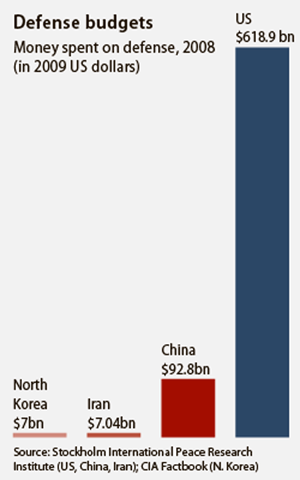Det danske Fredsakademi
Kronologi over fredssagen og international politik 8. August 2011 / Timeline August 8, 2011
Version 3.57. August 2011, 9. August 2011
08/08/2011
Panik på børserne i Asien breder sig til salg af
statsobligationer og faldende aktiekurser i resten af verden.
 |
 |
08/08/2011
How to Save a Quarter of a Trillion Dollars
By Lawrence S.
Wittner
In the midst of the current stampede to slash federal spending,
Congress might want to take a look at two unnecessary (and
dangerous) "national security" programs that, if cut, would save
the United States over a quarter of a trillion dollars over the
next decade.
The first of these is the Barack Obama
administration's plan to spend at least $185 billion in the next
ten years to "modernize" the U.S. government's nuclear weapons
arsenal. At present, the U.S. government possesses approximately
8,500 nuclear warheads, and it is hard to imagine that this country
would be safer from attack if it built more nuclear weapons or
"improved" those it already possesses. Indeed, President Barack
Obama has declared -- both on the 2008 campaign trail and as
President - that he is committed to building a world without
nuclear weapons. This seems like a perfectly sensible position --
one favored by most nations and, as polls show, most people
(including most people in the United States). Therefore, the
administration should be working on securing further disarmament
agreements -- not on upgrading the U.S. nuclear arsenal in
preparation for future nuclear confrontations and nuclear wars.
In late June of this year, Archbishop Desmond Tutu, a Nobel Peace
Prize laureate, wrote: "It is deeply troubling that the US has
allocated $185 billion to augment its nuclear stockpile over the
next decade, on top of the ordinary annual nuclear-weapons budget
of more than $50 billion." Not only has the International Court of
Justice affirmed that nations "are legally obliged to negotiate in
good faith for the complete elimination of their nuclear forces,"
but "every dollar invested in bolstering a country's nuclear
arsenal is a diversion of resources from its schools, hospitals,
and other social services, and a theft from the millions around the
globe who go hungry or are denied access to basic medicines." He
concluded: "Instead of investing in weapons of mass annihilation,
governments must allocate resources towards meeting human
needs."
Another project worth eliminating is the national missile defense
program. Thanks to recent Congressional generosity, this Reagan era
carryover, once derided by U.S. Senator Edward Kennedy as "Star
Wars," is currently slated for an increase in federal spending,
which will provide it with $8.6 billion in fiscal 2012.
The vast and expensive missile defense program -- costing about
$150 billion since its inception -- has thus far produced
remarkably meager results. Indeed, no one knows whether it will
work. As an investigative article in Bloomberg News recently
reported: "It has never been tested under conditions simulating a
real attack by an intercontinental ballistic missile deploying
sophisticated decoys and countermeasures. The system has flunked 7
of 15 more limited trials, yet remains exempted from normal
Pentagon oversight."
Carl Levin, the Michigan Democrat who chairs the Senate Armed
Services Committee, reported that his committee was "deeply
concerned" about the test failures of the nation's missile defense
program. He also implied that, given the disappearance of the
Soviet Union, the United States might not need such a system to
deter its potential enemies, which have a far inferior missile
capability. "The threat we have now is either a distant threat or
is not a realistic threat," he remarked.
Why, then, do other nations -- for example, Russia -- fiercely
object to the deployment of a U.S. missile defense system near
their borders? Perhaps they fear that, somehow, U.S. scientists and
engineers will finally figure out how to build a system, often
likened to hitting a bullet with a bullet, that makes the United
States invulnerable while they are left vulnerable. Or perhaps they
think that, one day, some U.S. government officials might believe
that the United States actually is invulnerable and launch a first
strike against their own nations. In any case, their favorite
solution to the problem posed by U.S. national missile defense --
building more nuclear-armed missiles of their own -- significantly
undermines the security of the United States.
Projecting the current annual cost of this program over the next
decade, the United States would save $86 billion by eliminating
it.
Thus, by scrapping plans for nuclear weapons "modernization" and
for national missile defense -- programs that are both useless and
provocative -- the United States would save $271 billion (well over
a quarter of a trillion dollars) in the next ten years. Whether
used to balance the budget or to fund programs for jobs,
healthcare, education, and the environment, this money would go a
long way toward resolving some of the nation's current
problems.
Dr. Lawrence Wittner is Professor of History emeritus at the State
University of New York/Albany. His latest book is Confronting the
Bomb: A Short History of the World Nuclear Disarmament Movement
(Stanford University Press).
|
|
|